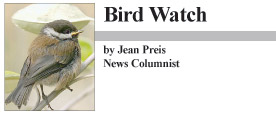Looking for owls
 This morning, we went for a walk in the park, where last night’s snow had finally turned the ground white, creating a wintry landscape. Our route led us up a snowy walkway to a unique, curving, covered footbridge over a brook. We paused there to look down at the shining water, and at a flock of mallards that swirled around quacking, attending to important mallard business. Beyond the bridge a path led us into the woods where old stonewalls, once proud boundary markers, now spilled their stones onto the ground. The woods were quiet. Traffic sounds had faded, replaced by the music of rushing water in the brook.
This morning, we went for a walk in the park, where last night’s snow had finally turned the ground white, creating a wintry landscape. Our route led us up a snowy walkway to a unique, curving, covered footbridge over a brook. We paused there to look down at the shining water, and at a flock of mallards that swirled around quacking, attending to important mallard business. Beyond the bridge a path led us into the woods where old stonewalls, once proud boundary markers, now spilled their stones onto the ground. The woods were quiet. Traffic sounds had faded, replaced by the music of rushing water in the brook.
A short way along the path we came upon a picture, of a man and a child under a full moon, that had been mounted on a board and tied to a stump. It was the cover of a children’s book, Owl Moon, written by Jane Yolen and illustrated by John Schoenherr. Farther along the path, we discovered additional pages of the book similarly displayed, placed there by a local library volunteer, for anyone walking the path to enjoy reading as they walk. The book tells the story of a father who takes his young daughter out one still, cold, winter night, under a full moon, to look for owls. As they walk very quietly through the snowy woods near their farm, the father stops occasionally to imitate the call of the great horned owl, hoping they will hear an owl respond.
Reading the story, we glanced up into the trees, and wondered if there might be an owl in these woods. Most of the trees near the path were leafless, offering no place for an owl to hide, but farther up the hill were tall white pine trees with thick foliage, where a great horned owl, a barred owl, or a tiny northern saw-whet owl might conceal itself. We have long been familiar with Patricia and Clay Sutton’s excellent book, How To Spot An Owl, so we knew that owls hunt at night or at dusk, and spend the day roosting out of sight in a tree. According to the Suttons, owls often roost where the woods meet an open area such as a field or a marsh. One way to discover them is to walk very quietly, carefully examining each tree from different angles and looking for the owl’s telltale droppings, known as whitewash, which can be seen on branches and on the trunk below a favorite perch. Another way to find owls is to listen at night in winter, when owls are courting and nesting and frequently call to one another. The authors of How To Spot An Owl remind us, though, that owls are predators who will protect their territory against any perceived threats, including too-curious owlers, and as with any wildlife watching, the safety and privacy of the owls is crucial. Recorded or repetitive owl calls should never be used during the breeding season, as an intruder, even a well-meaning one, could disturb the owls, and might even cause nesting failure.
In the children’s book, Owl Moon, the father and his little daughter are searching for a great horned owl, which is one of the owl species we have here in Maine. The great horned owl is a large, heavy bird, almost two feet long, with a wingspan close to four feet in width. With its long sharp talons this owl can capture and kill prey as large as muskrats, opossum, skunks, rabbits, and even young foxes. In our neighborhood, we have not heard or seen a great horned owl, but we hear and see barred owls fairly regularly. The barred owl is only slightly smaller than the great horned, but because it weighs only about half what the great horned weighs, it takes smaller prey, including mice, reptiles, and amphibians.
The father and daughter in Owl Moon walk until they come to a large moonlit clearing, and this time when the father calls the owl calls back. There is more to this delightful story, but it is best to discover the ending by walking over the covered bridge, along the path through the woods, and reading the pages of the book.

